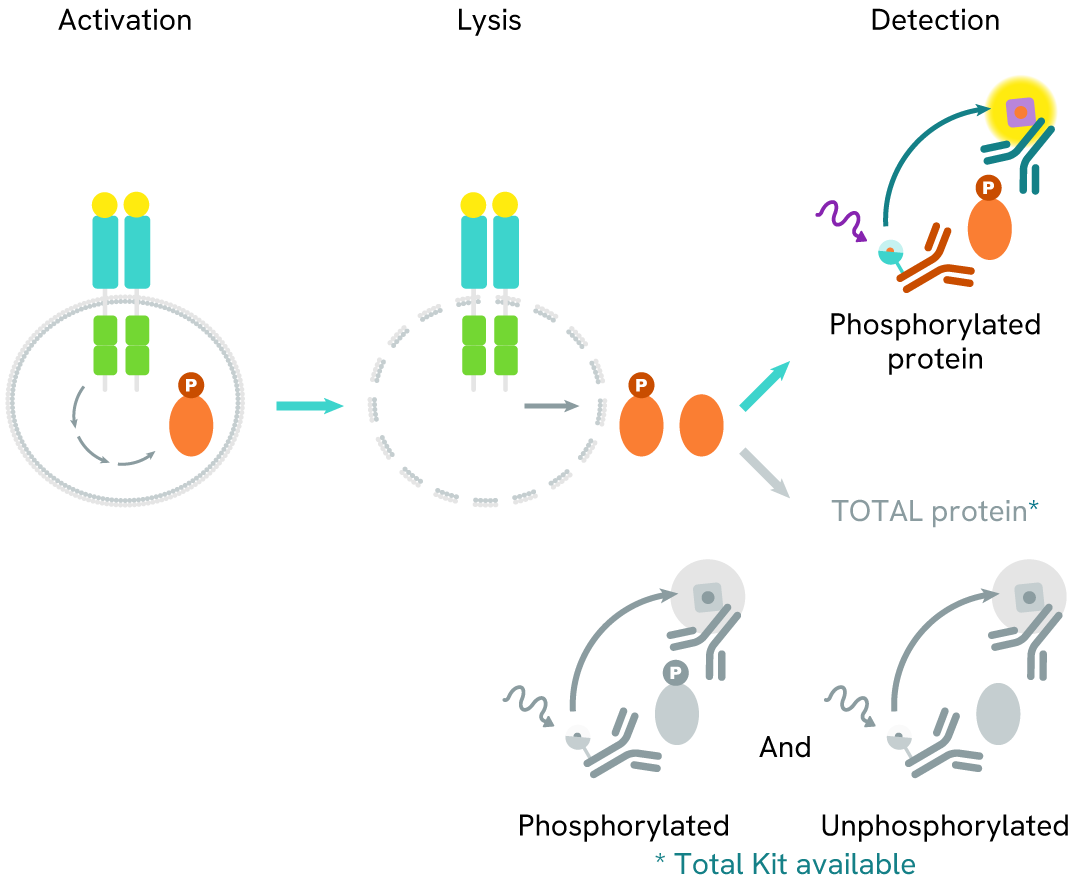

HTRF Phospho-ALK (Tyr1604) Detection Kit, 10,000 Assay Points
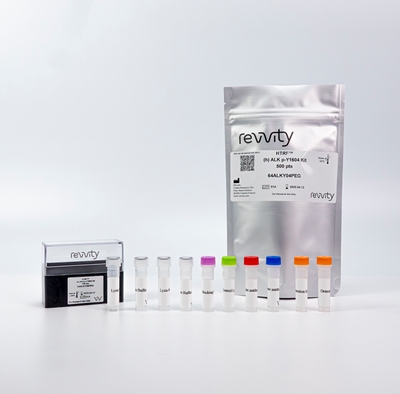
HTRF Phospho-ALK (Tyr1604) Detection Kit, 10,000 Assay Points
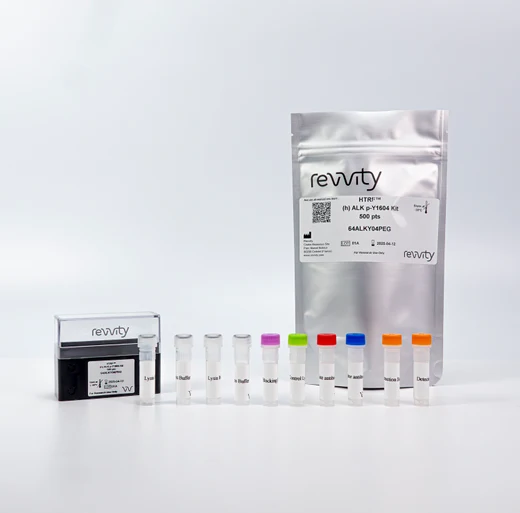

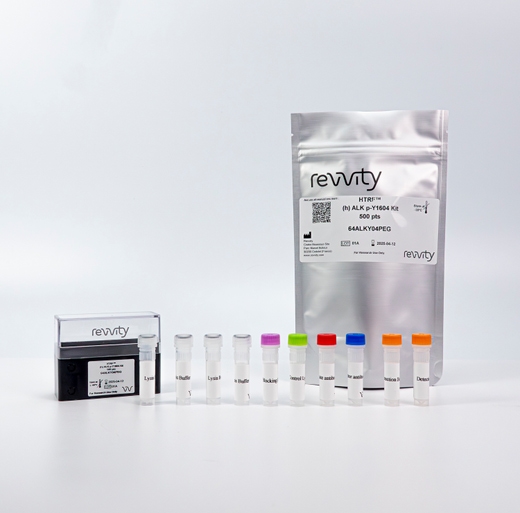

This HTRF kit enables the cell-based quantitative detection of ALK phosphorylation at Tyr1604.
For research use only. Not for use in diagnostic procedures. All products to be used in accordance with applicable laws and regulations including without limitation, consumption and disposal requirements under European REACH regulations (EC 1907/2006).
| Feature | Specification |
|---|---|
| Application | Cell Signaling |
| Sample Volume | 16 µL |
This HTRF kit enables the cell-based quantitative detection of ALK phosphorylation at Tyr1604.
For research use only. Not for use in diagnostic procedures. All products to be used in accordance with applicable laws and regulations including without limitation, consumption and disposal requirements under European REACH regulations (EC 1907/2006).


HTRF Phospho-ALK (Tyr1604) Detection Kit, 10,000 Assay Points


HTRF Phospho-ALK (Tyr1604) Detection Kit, 10,000 Assay Points


Product information
Overview
ALK (anaplastic lymphoma kinase) is a transmembrane tyrosine kinase belonging to the superfamily of insulin receptors. ALK regulates several pathways involved in cell survival, proliferation, and cell cycling, including the AKT/PI3K,MAPK/ERK, STAT3 and NFkB pathways.The ALK ligands, pleiotrophin (PTN) and midkine(MDK), induce ALK phosphorylation and activation on multiple Tyrosine including Y1604. ALK deregulation is associated with various cancers such as NSCLC, and neuroblastomas. Indeed, oncogenic ALK is driven by i) gene translocations and subsequent intracellular ALK fusion proteins (eg, EML4-ALK, NPM1-ALK, TPM3-ALK, VCL-ALK); ii) mutations (eg G263, R401, R551, P968 and E1242). Oncogenic ALK is constitutive active which results in uncontroled activation of downstream signaling pathways, leading to tumor cells survival and proliferation.
Specifications
| Application |
Cell Signaling
|
|---|---|
| Brand |
HTRF
|
| Detection Modality |
HTRF
|
| Lysis Buffer Compatibility |
Lysis Buffer 2
Lysis Buffer 4
|
| Molecular Modification |
Phosphorylation
|
| Product Group |
Kit
|
| Sample Volume |
16 µL
|
| Shipping Conditions |
Shipped in Dry Ice
|
| Target Class |
Phosphoproteins
|
| Technology |
TR-FRET
|
| Unit Size |
10,000 Assay Points
|
How it works
Phospho-ALK (Tyr1604) assay principle
The HTRF Phospho-ALK (Tyr1604) assay measures ALK when phosphorylated at Tyr1604. Unlike Western Blot, the assay is entirely plate-based and does not require gels, electrophoresis, or transfer. The Phospho-ALK (Tyr1604) assay uses 2 labeled antibodies: one with a donor fluorophore, the other with an acceptor. The first antibody was selected for its specific binding to the phosphorylated motif on the protein, and the second for its ability to recognize the protein independently of its phosphorylation state. Protein phosphorylation enables an immune-complex formation involving the two labeled antibodies and which brings the donor fluorophore into close proximity to the acceptor, thereby generating a FRET signal. Its intensity is directly proportional to the concentration of phosphorylated protein present in the sample, and provides a means of assessing the protein’s phosphorylation state under a no-wash assay format.

Phospho-ALK (Tyr1604) two-plate assay protocol
The two-plate protocol involves culturing cells in a 96-well plate before lysis, then transferring lysates into a 384-well low volume detection plate before the additon of the Phospho-ALK Tyr1604) HTRF detection reagents. This protocol enables the cells' viability and confluence to be monitored.
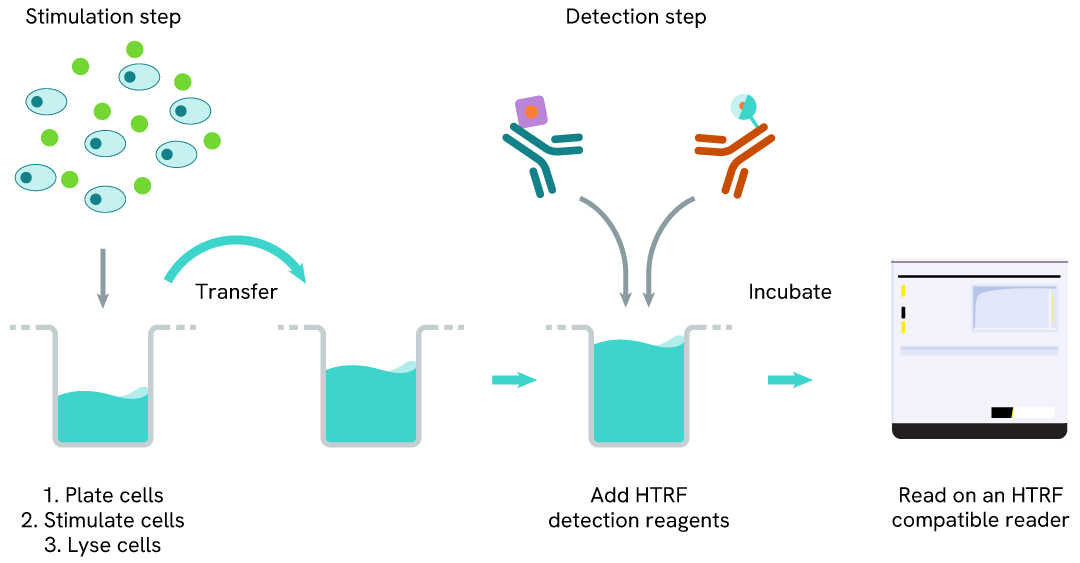
Phospho-ALK (Tyr1604) one-plate assay protocol
Detection of Phospho-ALK (Tyr1604) with HTRF reagents can be performed in a single plate used for culturing, stimulation, and lysis. No washing steps are required.
This HTS-designed protocol enables miniaturization while maintaining robust HTRF quality.
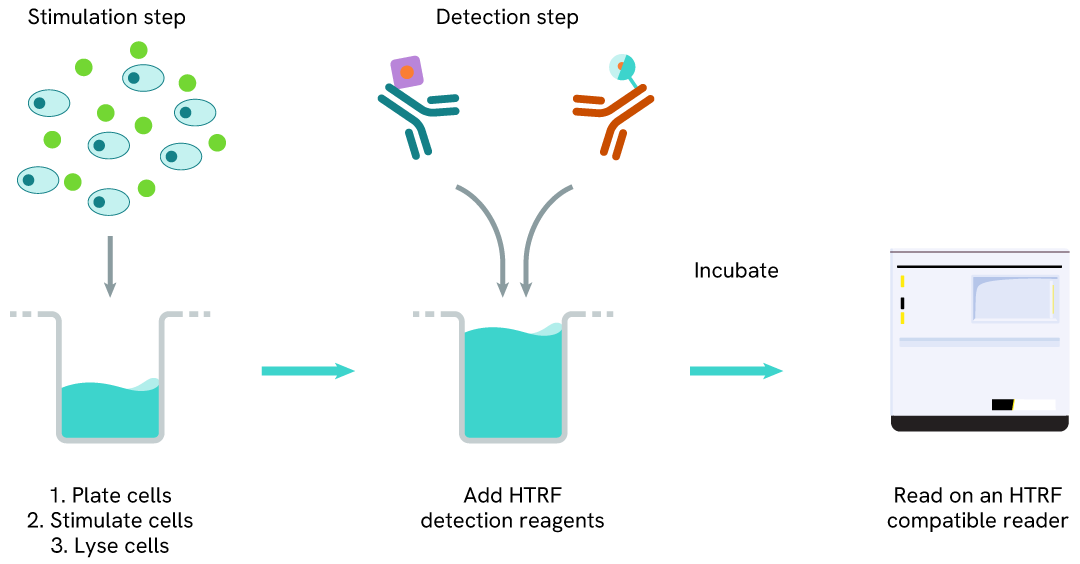
Assay validation
HTRF Phospho Y1604 ALK modulation using inhibitors on SU-DHL-1 cells
The experiments were performed using the two-plate assay protocol for suspension cells. SU-DHL-1 cells were plated in 96-well half area culture plates at a density of 10,000 cells/well and treated with increasing concentrations of three ALK inhibitors.
After 4 hours of incubation at 37°C, 5% CO2, 10µL of supplemented Lysis Buffer #4 (4X) were dispensed into each well for 30min.
Then 16 µL of lysates were transferred into a ProxiPlate-384 (# 6008280/9), and 4 µL of the HTRF Total Phospho Y1604 or HTRF Total ALK detection antibodies (HTRF Total ALK kit, Cat # 64ALKTPEG/H/Y) were added. The HTRF signals for both kits were recorded after an overnight incubation at RT.
Crizotinib and Ceritinib, the first two ALK inhibitors the FDA approved for NSCLC treatment, and Lolatinib, a third generation ALK inhibitor specifically designed to target patients with crizotinib resistance, triggered a dose-dependent decrease in the phosphorylation of ALK, as expected.
In the same conditions, these three inhibitors did not affect the expression level of Total ALK protein.
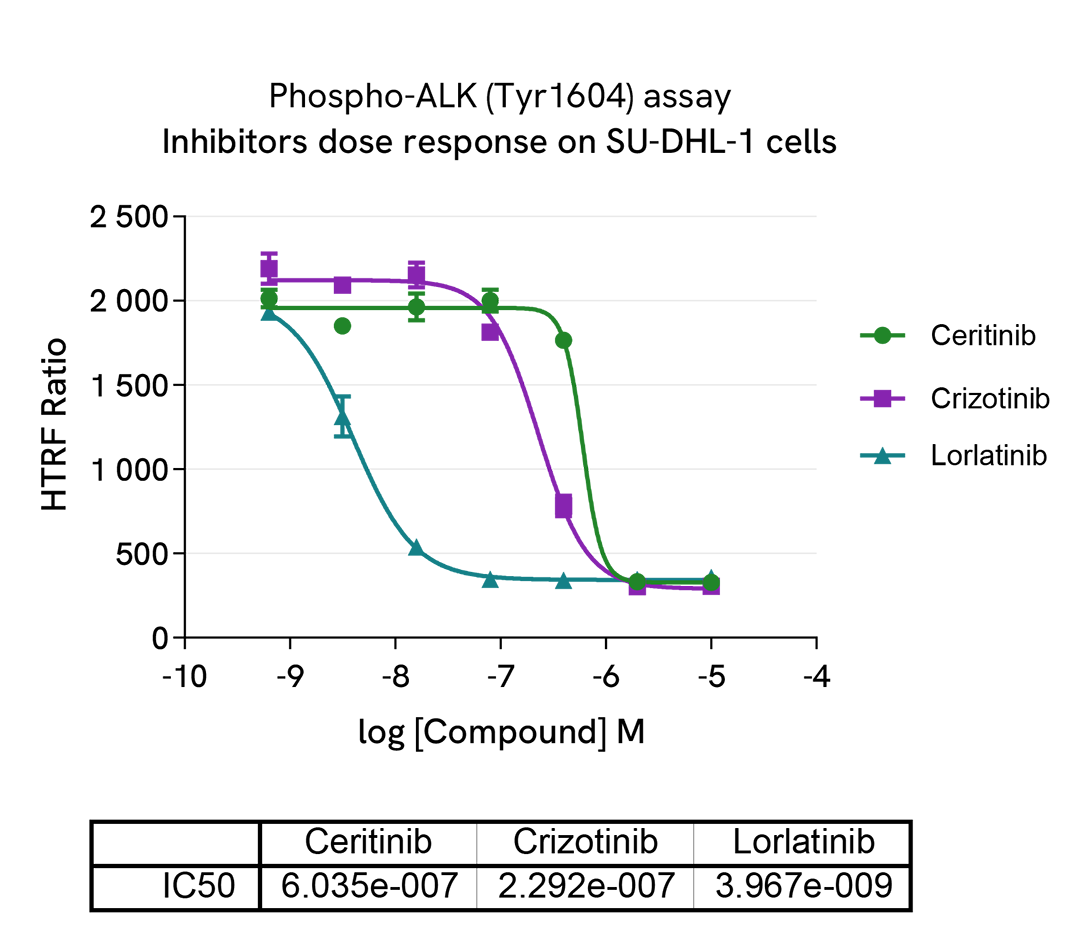
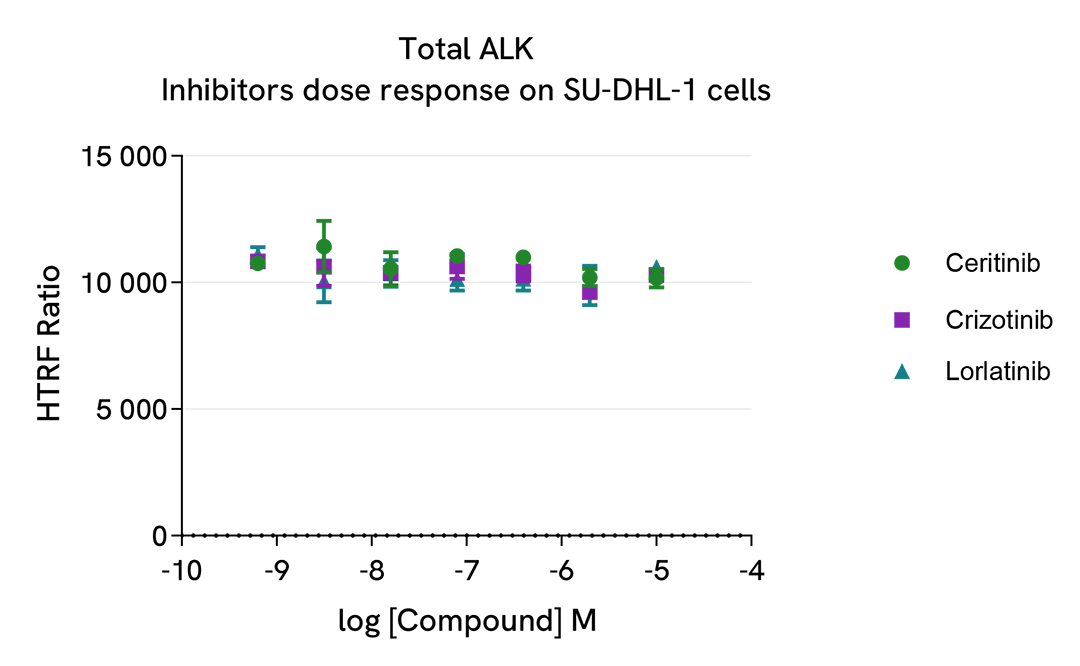
Comparison between HTRF and WB sensitivity on Phospho Y1604 ALK
SU-DHL-1 cells were cultured in a T175 flask in complete medium at 37°C, 5% CO2.
After centrifugation and medium removal, the cells were lysed with 3 mL of supplemented lysis buffer #4 (1x) for 30 min at RT under gentle shaking.
Serial dilutions of the cell lysate were performed using supplemented lysis buffer #4 (1x), and 16µL of pure sample. Each dilution was transferred into a 384-well small volume microplate before the addition of 4µL of HTRF Phospho Y1604 ALK detection antibodies. The HTRF signals were recorded after an overnight incubation.
Equal amounts of lysates were loaded into a gel for a side by side comparison between HTRF and Western Blot.
In these conditions, the HTRF Phospho Y1604 ALK assay is 64-fold more sensitive than the Western Blot.
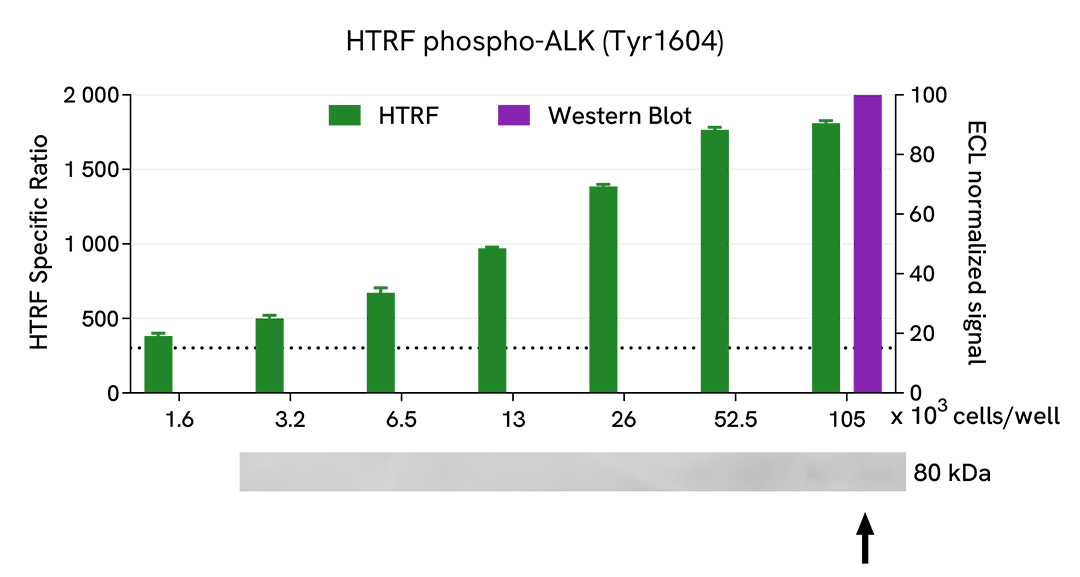
Simplified pathway
ALK (anaplastic lymphoma kinase) is a transmembrane tyrosine kinase which regulates cell survival, proliferation, and cell cycling, The ALK ligands, pleiotrophin (PTN) and midkine (MDK), induce ALK phosphorylation and activation on multiple Tyrosine including Y1604 which activates multiple signaling pathways such as AKT/PI3K,MAPK/ERK, STAT3 and NFkB pathways.
Constitutive activation of oncogenic ALK fusion proteins or mutated ALK is associated with various cancers such as NSCLC, and neuroblastomas.
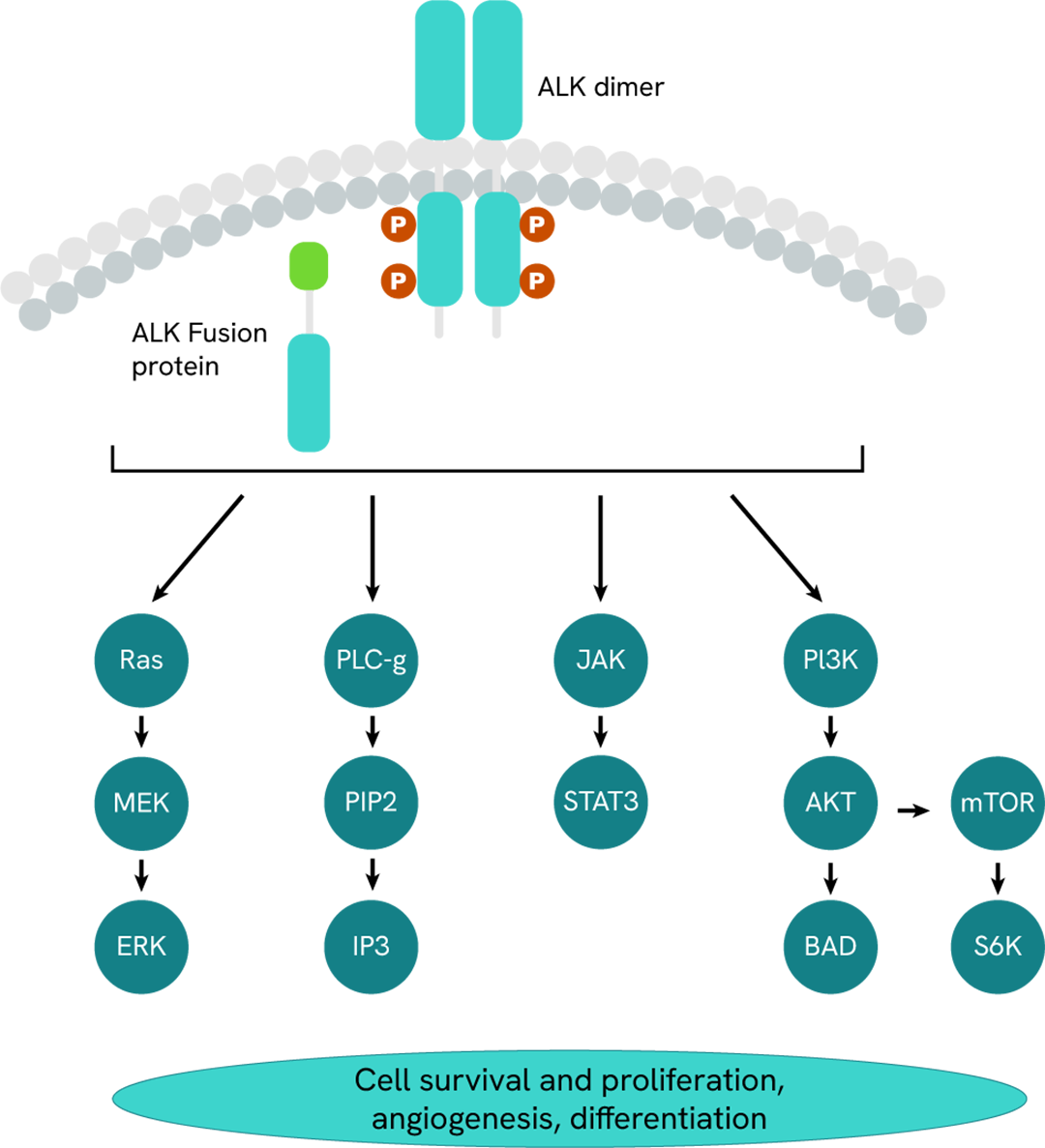
Resources
Are you looking for resources, click on the resource type to explore further.
HTRF: unfamiliar territory?
This technical brochure reviews the general principles of HTRF™ and the associated Tag-lite™ technology...
Your guide for improving cell signaling assay performance
This complete Revvity guide provides you with all the tools you need to...


How can we help you?
We are here to answer your questions.






























